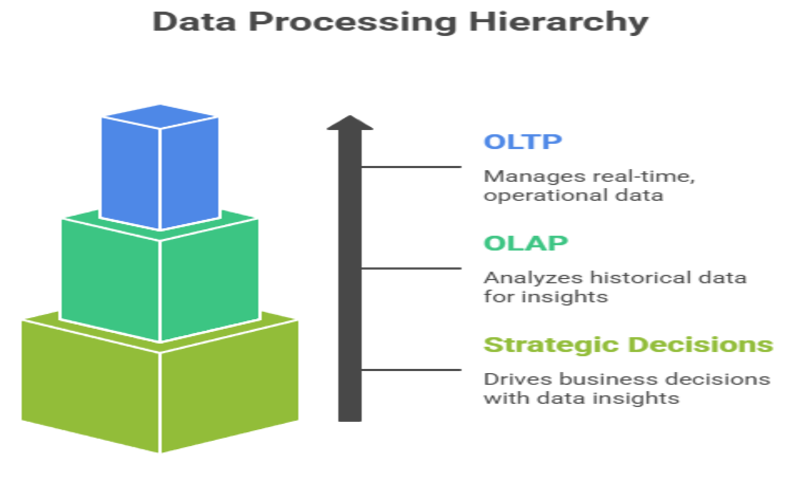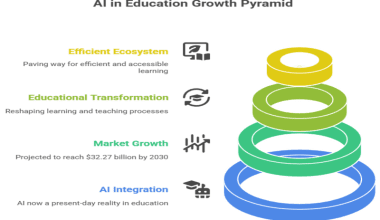Summary: Explore the fundamental difference between OLAP and OLTP. OLTP systems handle fast, real-time transactions like ATM withdrawals, while OLAP systems analyze vast historical data for strategic insights and business intelligence. This blog covers their distinct architectures, use cases, and importance in today’s data-driven world.
Introduction
In today’s data-driven world, understanding how data is processed is crucial for any business aiming to thrive. Two fundamental concepts that form the bedrock of data management are OLAP and OLTP.
While they might sound like complex acronyms, their roles are distinct and vital for everything from your daily transactions to long-term business strategy. This blog will demystify the difference between OLAP and OLTP, exploring their unique architectures and how they function as distinct data processing systems.
At a high level, the primary distinction lies in their purpose. Online Transaction Processing (OLTP) is all about managing real-time, operational data. Think of it as the engine that powers your everyday interactions, like an ATM withdrawal or an online purchase.
On the other hand, Online Analytical Processing (OLAP) is designed for in-depth analysis of large volumes of historical data to uncover trends, patterns, and insights that drive strategic business decisions.
Key Takeaways
- OLTP systems are for running daily business operations in real-time.
- OLAP systems are for analyzing historical data to support decisions.
- Transactional vs. analytical systems is the core difference between the two.
- OLTP uses a normalized database; OLAP uses a denormalized one.
- Both OLAP and OLTP are crucial for a complete data strategy.
Difference Between OLAP and OLTP in Database
The foundational differences between OLAP and OLTP stem from their core functions, which in turn dictate their database design and architecture.
An OLTP database is structured to handle a high volume of short, fast transactions from a large number of concurrent users. These systems are optimized for rapid data entry, updates, and deletions. To ensure data integrity and speed, OLTP databases are typically normalized.
Normalization reduces data redundancy and protects data integrity, which is crucial when dealing with transactional records. Imagine a busy e-commerce site; the OLTP system is what allows thousands of customers to make purchases simultaneously without a hitch.
In stark contrast, an OLAP database is built for complex queries and analysis, not for rapid-fire transactions. These systems are often part of a data warehouse and contain historical data aggregated from various OLTP systems.
The data in an OLAP system is often denormalized and structured in a multidimensional way, using schemas like star or snowflake. This structure allows analysts to “slice and dice” the data from different perspectives to gain a comprehensive understanding of business performance over time.
To put it simply, OLTP systems are about running the business, while OLAP systems are about understanding the business. Here’s a breakdown of their key distinctions:
- Primary Purpose: OLTP is for processing real-time transactions, while OLAP is for analyzing aggregated historical data.
Data Source: OLTP systems use current, operational data from a single source, whereas OLAP
What’s the Difference Between OLAP & OLTP?
- Query Type: OLTP involves simple, predefined queries like inserting or updating a single record. OLAP, on the other hand, deals with complex queries that may involve aggregating millions of records.
- Response Time: OLTP systems are designed for near-instantaneous response times, often measured in milliseconds. OLAP queries, due to their complexity, can take seconds or even minutes to execute.
- Users: Front-line workers like cashiers, bank tellers, and customer service representatives are the primary users of OLTP systems. In contrast, data analysts, business intelligence professionals, and executives are the main users of OLAP systems.
To truly grasp the difference between OLAP and OLTP, it’s helpful to look at real-world examples. These scenarios highlight how each system is designed for a distinct purpose: one for handling immediate transactions and the other for in-depth analysis.
OLTP: The Engine of Daily Operations
Online Transaction Processing (OLTP) systems are all around us, working silently in the background to facilitate our daily activities. They are built for speed and accuracy, handling a high volume of short, simple transactions from many users at once.
Key characteristics of OLTP systems include
- Real-time processing: Transactions are processed immediately.
- High concurrency: They can handle thousands or even millions of users at the same time.
- Data integrity: They ensure that data remains accurate and consistent, a crucial feature for transactional systems.
Common Examples of OLTP Systems in Action
Banking and Finance
The classic example of an OLTP system is an ATM. When you withdraw cash, the system instantly processes the transaction, updates your account balance, and dispenses the money. Other examples in this sector include online banking applications and credit card payment processing.
E-commerce and Retail
When you buy something online, the OLTP system processes your order, manages inventory, and handles the payment. In a physical store, the point-of-sale (POS) terminal is an OLTP system that records the sale and updates inventory levels in real-time.
Travel and Reservations
Booking a flight or a hotel room involves an OLTP system. These systems manage reservations, ensuring that the same seat or room isn’t booked by multiple people simultaneously.
Healthcare
Electronic health record (EHR) systems use OLTP to manage patient data, schedule appointments, and process billing.
OLAP: The Compass for Strategic Decisions
While OLTP systems are busy recording the “what” of business transactions, Online Analytical Processing (OLAP) systems focus on understanding the “why.” They are design to analyze large volumes of historical data from various sources to identify trends, patterns, and insights.
Key Features of OLAP Systems
- Multidimensional analysis: Data often structure in “cubes” that allow users to “slice and dice” it from different perspectives.
- Complex queries: They optimize to handle complex queries that aggregate large amounts of data.
- Support for business intelligence: OLAP is a cornerstone of business intelligence (BI), providing the analytical power for reports, dashboards, and data mining.
Examples of How Businesses Use OLAP Systems
Sales and Marketing Analysis
A retail company can use an OLAP system to analyze sales data over several years, broken down by product, region, and season. This could reveal that a certain product sells best in a specific region during the summer, allowing them to optimize their marketing campaigns and inventory. A market basket analysis, for instance, can identify which products are frequently purchased together.
Financial Analysis and Forecasting
OLAP systems extensively use for financial reporting, budgeting, and forecasting. A company can analyze its financial performance over time, identify areas of high expenditure, and create more accurate budgets for the future.
Demand Planning
By analyzing historical sales data and market trends, businesses can use OLAP to forecast customer demand. This helps in optimizing inventory levels and ensuring that popular products are always in stock.
Healthcare Analytics
Healthcare providers can use OLAP to analyze patient outcomes based on various factors like treatment plans, demographics, and medical histories. This can lead to improved patient care and more effective treatment protocols.
In essence, OLTP and OLAP are two sides of the same data coin. OLTP captures the individual transactions that are the lifeblood of a business, while OLAP transforms that raw data into the knowledge that guides strategic direction.
Frequently Asked Questions
What is the Difference between OLAP and OLTP in a Data Warehouse?
In a data warehousing context, OLTP systems are the source of raw, transactional data. This data is then extracted, transformed, and loaded (a process known as ETL) into a data warehouse.
The data warehouse itself is an OLAP system, designed to store and analyze this historical data. Therefore, the OLTP system feeds the OLAP system, enabling businesses to perform in-depth analysis on the vast amounts of transactional data they collect.
What is the Difference between OLAP and OLTP in Business Intelligence?
Business Intelligence (BI) heavily relies on OLAP systems to function. BI tools and applications design to help users explore and visualize data to make informed business decisions.
The underlying engine that powers these BI tools is an OLAP system, which provides the multidimensional data structures and analytical capabilities needed for tasks like creating dashboards, generating reports, and performing trend analysis. OLTP systems, while crucial for capturing the initial data, are not directly use for BI analysis due to their transactional focus.
Is Snowflake OLAP or OLTP?
Snowflake primarily designed as an OLAP database system. Its architecture optimized for complex analytical queries on large datasets. Snowflake’s columnar storage format is a key feature that makes it highly efficient for the read-heavy workloads characteristic of OLAP. While it can use for some transactional workloads, its core strength and design purpose align with analytical processing
Conclusion: Choosing the Right Tool for the Job
In the vast landscape of data processing systems, both OLAP and OLTP play indispensable and complementary roles. OLTP systems are the transactional workhorses, ensuring the smooth and efficient operation of day-to-day business activities. OLAP systems, in turn, leverage the data captured by OLTP to provide the deep analytical insights that are essential for strategic growth and innovation.
Understanding the fundamental difference between these two systems is the first step toward building a robust and effective data strategy. For businesses looking to harness the power of their data, recognizing when to use an OLTP database for transactional efficiency and when to employ an OLAP system for analytical depth is key to unlocking a competitive advantage.
If you are looking to deepen your understanding of data systems and how to leverage them for your business, consider exploring our comprehensive courses and services. We provide the expertise to help you navigate the complexities of data architecture and empower your organization to make data-driven decisions with confidence.




